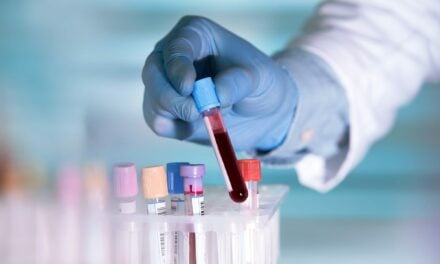Qiagen NV, Hilden, Germany, and Germantown, Md, has recently announced the launch of three innovative sample-to-insight panel tests for next-generation sequencing (NGS) research in oncology using Qiagen’s GeneReader NGS system and other NGS platforms.
Two new GeneRead QIAact panels for use on Qiagen’s GeneReader NGS system deliver more powerful genomic insights, one covering a wide range of cancer-causing variants and the other focusing on genes tied to breast and ovarian cancers. Additionally, a new QIAseq panel is being launched for use on any NGS system to measure tumor mutational burden (TMB), an emerging biomarker for use in assessing how a patient may respond to checkpoint inhibitors, which are a form of cancer immunotherapy.
“Qiagen’s expansion in next-generation sequencing is fueled by a significant momentum in innovation and also by partnerships with pharmaceutical companies developing companion diagnostics for their drugs,” says Peer M. Schatz, chief executive officer at Qiagen. “These new panels provide even deeper analysis in cancer profiling for GeneReader NGS customers and for immunooncology researchers, deploying best-in-class technologies for accurate detection and valuable insights.”
The new solutions are also linked to Qiagen’s bioinformatics for analysis and interpretation, delivering actionable insights to support clinical researchers worldwide, says Schatz. “As NGS moves toward increasingly routine use, laboratories are turning to Qiagen’s sample-to-insight solutions to achieve valuable insights with best-in-class efficiency, accuracy, and ease of use.”
GeneReader Workflows for Oncology
The two new workflows for the GeneReader NGS system deliver powerful analysis by expanding gene coverage and variant types and using Qiagen’s proprietary ‘digital NGS’ technology to enable more accurate quantification, detection, and interpretation of variants. The new workflows involve:
- The GeneRead QIAact actionable insights tumor DNA UMI panel broadens coverage from 12 to 30 genes that influence the development and progression of the most widespread cancers, including lung, melanoma, prostate, and other solid tumors. The workflowtargets more than 850 DNA variants in hotspot regions as well as 125 full exons.
- The GeneRead QIAact BRCA advanced UMI panel enables analysis of the full exon coding sequences of the BRCA1, BRCA2, TP53, and PTEN genes, which play key roles in the development and progression of breast, ovarian, and other cancers. The workflow will enable alignment with guidelines of the National Comprehensive Cancer Network (NCCN) on the need for comprehensive testing that encompasses full BRCA1/2 sequencing and detection of large gene rearrangements.1
A highlight of the new solutions is detection of copy number variations (CNVs) down to the exon level, as well as of larger deletions that are pathogenic but are often overlooked by NGS technologies lacking an optimized end-to-end solution. The seamlessly integrated GeneReader system effectively detects CNVs, as well as alterations in noncoding intronic DNA regions, which can undermine the body’s tumor suppressor genes.
The GeneRead QIAact assays come with a preoptimized and preverified sample-to-report workflow, including all steps from sample extraction to variant interpretation with Qiagen Clinical Insight (QCI) Interpret (research use only). Integration with QCI Interpret leverages the expertly curated Qiagen knowledge baseto provide an up-to-date interpretation of variants using international guidelines for variant classification. Such access enables labs to more quickly detect and interpret hundreds of DNA mutations that can influence the development and progression of cancer.
Open-Platform Immunooncology Panel
The new QIAseq TMB panel represents an advanced breadth of immunooncology-related biomarkers and provides in-depth analysis of emerging biomarkers with the potential to predict responses to immunotherapy in advanced cancers, such as the growing class of checkpoint inhibitors.
The QIAseq TMB panel is designed to run on any commercial NGS platform, and the workflow targets variants in 486 genes covering full exons. In a single panel, QIAseq TMB detects tumor mutational burden (TMB), the total number of mutations in coding areas of a tumor genome; microsatellite instability (MSI), a predisposition to genetic mutations due to impaired DNA repair capability; single nucleotide variants (SNVs), changes in a single strand of DNA; and Indels, small insertions or deletions in DNA.
The QIAseq TMB panel generates data with higher sensitivity and lower requirements for DNA input (40 ng) than whole-exome or smaller targeted panels for research applications. The panel incorporates unique molecular indexes, which tag every molecule in a sample at an early stage to eliminate errors in downstream analysis and produce higher quality results.
For further information, visit Qiagen.
Reference
- Daly MB, Pilarski R, Buys SS, et al. Genetic/Familial High-Risk Assessment: Breast and Ovarian. NCCN Clinical Practice Guidelines in Oncology, ver. 1.2018 [online]. Plymouth Meeting, Pa: National Comprehensive Cancer Network, 2017. Available at: https://www2.tri-kobe.org/nccn/guideline/gynecological/english/genetic_familial.pdf. Accessed December 18, 2018.
Featured image: The GeneReader NGS system from Qiagen.





